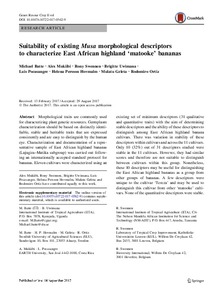| dc.contributor.author | Batte, M. |
| dc.contributor.author | Mukiibi, A. |
| dc.contributor.author | Swennen, R.L. |
| dc.contributor.author | Uwimana, B. |
| dc.contributor.author | Pocasangre, L. |
| dc.contributor.author | Hovmalm, H.P. |
| dc.contributor.author | Geleta, M. |
| dc.contributor.author | Ortiz, R. |
| dc.date.accessioned | 2019-12-04T11:10:45Z |
| dc.date.available | 2019-12-04T11:10:45Z |
| dc.date.issued | 2018 |
| dc.identifier.citation | Batte, M., Mukiibi, A., Swennen, R., Uwimana, B., Pocasangre, L., Hovmalm, H.P., ... & Ortiz, R. (2018). Suitability of existing Musa morphological descriptors to characterize East African highland ‘matooke’bananas. Genetic Resources and Crop Evolution, 1-13. |
| dc.identifier.issn | 0925-9864 |
| dc.identifier.uri | https://hdl.handle.net/20.500.12478/2257 |
| dc.description | Article purchased; Published online: 18 Sept 2017 |
| dc.description.abstract | Morphological traits are commonly used for characterizing plant genetic resources. Germplasm characterization should be based on distinctly identifiable, stable and heritable traits that are expressed consistently and are easy to distinguish by the human eye. Characterization and documentation of a representative sample of East African highland bananas (Lujugira–Mutika subgroup) was carried out following an internationally accepted standard protocol for bananas. Eleven cultivars were characterized using an existing set of minimum descriptors (31 qualitative and quantitative traits) with the aim of determining stable descriptors and the ability of these descriptors to distinguish among East African highland banana cultivars. There was variation in stability of these descriptors within cultivars and across the 11 cultivars. Only 10 (32%) out of 31 descriptors studied were stable in the 11 cultivars. However, they had similar scores and therefore are not suitable to distinguish between cultivars within this group. Nonetheless, these 10 descriptors may be useful for distinguishing the East African highland bananas as a group from other groups of bananas. A few descriptors were unique to the cultivar ‘Tereza’ and may be used to distinguish this cultivar from other ‘matooke’ cultivars. None of the quantitative descriptors were stable. |
| dc.format.extent | 1-13 |
| dc.language.iso | en |
| dc.subject | Cultivar |
| dc.subject | Descriptors |
| dc.subject | Bananas |
| dc.subject | Hybridization |
| dc.subject | Plant Genetic Resources |
| dc.subject | Morphological Traits |
| dc.subject | East African Highland Bananas |
| dc.subject | Traits |
| dc.subject | Germplasm |
| dc.title | Suitability of existing Musa morphological descriptors to characterize East African highland ‘matooke’ bananas |
| dc.type | Journal Article |
| dc.description.version | Peer Review |
| cg.contributor.affiliation | International Institute of Tropical Agriculture |
| cg.contributor.affiliation | Swedish University of Agricultural Sciences |
| cg.contributor.affiliation | EARTH University |
| cg.contributor.affiliation | Katholieke Universiteit Leuven |
| cg.contributor.affiliation | Bioversity International |
| cg.coverage.region | Africa |
| cg.coverage.region | East Africa |
| cg.coverage.country | Uganda |
| cg.researchtheme | BIOTECH & PLANT BREEDING |
| cg.isijournal | ISI Journal |
| cg.authorship.types | CGIAR and advanced research institute |
| cg.iitasubject | Banana |
| cg.iitasubject | Genetic Improvement |
| cg.iitasubject | Plant Breeding |
| cg.iitasubject | Plant Genetic Resources |
| cg.iitasubject | Plant Production |
| cg.journal | Genetic Resources and Crop Evolution |
| cg.howpublished | Formally Published |
| cg.accessibilitystatus | Open Access |
| local.dspaceid | 91795 |
| cg.targetaudience | Scientists |
| cg.identifier.doi | http://dx.doi.org/10.1007/s10722-017-0562-9 |


